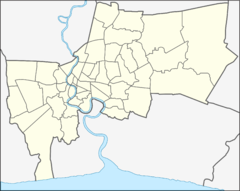Wat Mangkon Kamalawat
| Wat Mangkon Kamalawat | |
|---|---|
 |
|
| Basic information | |
| Geographic coordinates | 13°44′38″N 100°30′34″E / 13.743828°N 100.509552°E |
| Affiliation | Buddhism |
| Country | Thailand |
| Architectural description | |
| Founder | King Nangklao (Rama III) |
| Completed | 1846 |
Wat Mangkon Kamalawat (Thai: วัดมังกรกมลาวาส), previously (and still commonly) known as Wat Leng Noei Yi (Thai: วัดเล่งเน่ยยี่, Chinese: 龍蓮寺、龙莲寺; pinyin: Lónglián Sì), is the largest and most important Chinese Buddhist temple in Bangkok, Thailand. It hosts celebrations of a number of year-round events, including Chinese New Year, and the annual Chinese vegetarian festival.
It is located in the district of Pom Prap Sattru Phai in the city's Chinatown, in a courtyard off Charoen Krung Road, accessed by an alleyway.
Wat Mangkon Kamalawat was founded as a Mahayana Buddhist temple in 1871 or 1872 (sources differ), by Phra Archan Chin Wang Samathiwat (also known as Sok Heng), initially with the name Wat Leng Noei Yi. It was later given its current name, Wat Mangkon Kamalawat, meaning "Dragon Lotus Temple", by King Chulalongkorn (Rama V).
The temple is built in a classic Chinese architectural style, with typical sweeping tiled roofs decorated with animal and floral motifs, including the ubiquitous Chinese dragons. The ubosot (ordination hall) houses the temple's main, gold colored, Buddha image in the Chinese style, and is fronted by an altar at which religious rites are performed.
The main entrance to the viharn (sermon hall) is flanked by large statues of the four guardians of the world, the Chatulokkaban, clothed in warrior costumes, two on each side. Around the temple there are shrines dedicated to a variety of Buddhist, Taoist and Confucian deities and religious figures, all important in local Chinese beliefs.
...
Wikipedia

